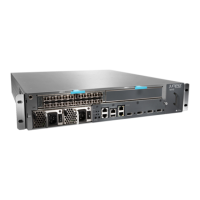A blown fuse can cause a component to fail even though it is correctly installed and the
power supplies are functioning. Check for a blown fuse in the following circumstances:
• The LED that indicates normal operation for the component fails to light.
• The appropriate show chassis environment command indicates that the component
is installed but is not receiving power.
Perform an MCS Swap Test
Purpose The MCS can fail and not start, or it can cause a connectivity problem between the
Routing Engine and the Packet Forwarding Engine components, such as the Flexible PIC
Concentrator (FPC) and Switching and Forwarding Module (SFM). You can perform a
swap test on the MCS to try to pinpoint the problem.
CAUTION: The MCS is hot-pluggable. Routing functions are interrupted until
a replacement is installed. You should perform a swap test during a
maintenance window.
CAUTION: Before performing a swap test, always check for bent pins in the
midplane and check the MCS for stuck pins in the connector. Pins stuck in
the component connector can damage other good slots during a swap test.
Action To perform a swap test on an MCS, remove it and replace it with one that you know
works.
Normally, if two host modules are installed in the router, HOST0 functions as the master
and HOST1 as the backup. You can remove the backup host module (or either of its
components) without interrupting the functioning of the router. If you take the master
host module offline, the router reboots and the backup host module becomes the master.
If the router has only one host module, taking it offline causes the router to shut down.
The host module is taken offline and brought back online as a unit. Before you replace
the Routing Engine or an MCS, you must take the host module offline; the host module
is hot-pluggable.
To remove an MCS:
1. Place an electrostatic bag or antistatic mat on a flat, stable surface to receive the
Routing Engine.
2. Attach an electrostatic discharge (ESD) strap to your bare wrist, and connect the
strap to one of the ESD points on the chassis.
3. Remove the rear component cover by loosening the screws at the corners of the cover
and pulling it straight off of the chassis.
461Copyright © 2012, Juniper Networks, Inc.
Chapter 19: Monitoring the MCS

